If you’re reading this post, you’ve already realized one fundamental thing: Instagram is a critically important social network. The photo-sharing app is not only important for retailers, restaurants, or travel companies; as one of the most effective brand-building tools available today, Instagram is increasingly important for every kind of business.
Instagram is now a hub where regular people find (and judge) the visual identity of a business. Without a strong Instagram presence, companies risk being ignored or forgotten, especially among the next generation of consumers. Among American teens,Instagram is actually considered the single most important social network.
If you do take Instagram seriously, it can open up a world of opportunity for your brand. Forrester has named Instagram the “king of social engagement,” citing the fact that top brands’ Instagram posts generated a per-follower engagement rate of 4.21 percent. That means Instagram delivered these brands 58 times more engagement per follower than Facebook, and 120 times more engagement per follower than Twitter.
So, you now know why your business should be on Instagram. Below, we tackle the “how,” walking you through the process of building an Instagram strategy, setting up your account, and best practices for brands. Read on for our beginner’s guide on how to use Instagram for business.
Create your Instagram strategy

Start off by doing some research. Use Instagram yourself, before you use it for your brand. Check out the best businesses on Instagram, and other brands in your industry—including your competitors—both for inspiration and competitive intelligence.
Once you’re familiar with the app, you can begin to build your Instagram strategy. This strategy should mirror your broader social media marketing plan, which acts as your business’ guide for social media activities.
First, you’ll need to establish your Instagram goals. These goals should tie back to your business goals. They might include:
- Increase product sales
- Increase traffic to your website
- Increase brand awareness
- Increase branded hashtag mentions
The goals you set for your Instagram strategy should all be achievable and measurable. For example, you shouldn’t set a goal to increase your white paper downloads if you can’t tie your Instagram activities to your white papers (hint: this would be really hard and probably wouldn’t work). By creating goals that are measurable, you also allow yourself to track your progress, which we’ll discuss in more detail below.
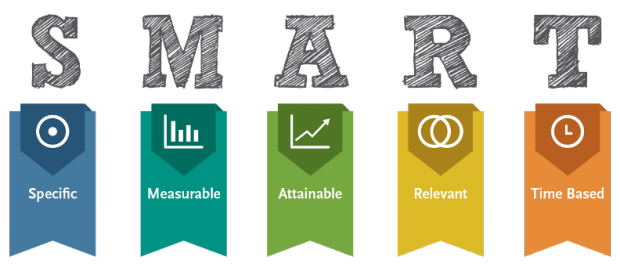
Once you identify your goals, craft a mission statement for your Instagram account. A mission statement acts as a guiding principle for your Instagram activities, and will dissuade you from treating the social network like you would Twitter or Facebook. Specific features of each social media network lend themselves to certain goals. In the case of Instagram, the network’s power is in visuals, and your mission statement and goals should reflect that. The statement will likely take on a format similar to:
We will use Instagram for (purpose of this social network) in order to help (business goal).
With your mission statement in hand, you can move onto your content strategy. This will involve:
- Choosing how often to post
- Choosing what time of day to post
- Establishing a content calendar
- Choosing your content themes
On Instagram, you should be maintaining a regular posting schedule, but you don’t want to bombard your followers with too many posts. Most brands release one to three posts per day. As for what time of day to post, this will largely depend on your audience. For both of these factors, frequency and time, it should come down to testing. Test posts at different intervals and times and see what works best. This will depend on where your audience is located, including their timezone, among other factors. Then use that insight to establish a content calendar. Your calendar should establish who is in charge of posting, when they’ll post, and what the content will be.
With Hootsuite’s new Instagram integration, you can then schedule your Instagram posts in advance. This will allow you to save time on posting every day, allowing you to dedicate more of your resources to engagement and community building. Spend a bit of time each week scheduling your Instagram images at your audience’s most active times, and then check back in as necessary.
Choosing the themes and subject matter for your content is a big deal on Instagram, so we’re going to look at it in more detail:
Build your Instagram brand
Instagram is all about the visuals, so you need to set out to build a cohesive, recognizable brand identity. How you approach your Instagram brand will be influenced by the strategy you have already determined.
First, consider the visual style you want for your Instagram brand. Choose one filter or a set of filters that you will use for the majority, if not all of your photos. By using the same filters over and over, you establish a style that will become recognizable to your followers. Since your goal is to get Instagram users to stop scrolling once they see your image (in order to engage with it by liking or commenting), the more instantly recognizable your photos are, the better.
Take a look at 33 Acres Brewing Company, which uses white borders and a very white colour pallet in the majority of their Instagram photos. Scrolling through their feed, the style quickly becomes familiar and you start to associate images that meet these characteristics with the brewery.

Other mobile photo editing apps like VSCOcam and Whitagram can provide additional filters or editing options to help you find your style. Photos that have been edited or filtered elsewhere can still be imported into Instagram.
Visually, you’ll also need to decide what content your photos will focus on. In some cases, the content will be obvious: a clothing line will shoot photos of clothes, a restaurant will shoot photos of its food. Not all industries have this luxury, but brands from all industries are finding ways to promote themselves through lifestyle content, which seems to connect well with the Instagram audience.
You don’t have to be a lifestyle brand to post lifestyle content. Hootsuite is a social media management company, but we share Instagram photos of our staff members, our dogs and our offices, since this represents the character and culture of our business.
If you’re unsure of how to visually represent your own company, monitor the accounts of your followers. Look at what they’re sharing and see if you can identify any trends. Then replicate the visual themes in your own content. An accounting firm might find their followers are very passionate about coffee or cars, and share content from their employees which fits these themes. Or these brands could share their followers’ photos (giving them full credit of course) as a form of user-generated content. Marker company Sharpie uses UGC regularly in their feed, interspersing it with product photos to great effect. The use of UGC and lifestyle content makes those product shorts feel less obtrusive and salesy as a result.

Finally, there may be non-visual elements to your Instagram brand, like common language or style for captions. A popular technique used by brands is the branded hashtag.This doesn’t mean simply using your company name as a hashtag (don’t do that). This is about finding a hashtag that embodies your Instagram brand and encouraging followers to share photos that fit that image. Brands receive the benefit of increased exposure to new potential customers, and Instagrammers participate for a chance to be featured on a brand’s profile—as well as the prestige and the increase in followers that accompanies it.
Hootsuite’s branded hashtag is #Hootsuitelife. Lululemon Athletica has users tag their workout photos with #thesweatlife, which has generated tens of thousands of posts from their community. Poler Stuff has not one, but four branded hashtags (#campvibes, #adventuremobile, #bagitandtagit and #beneaththebrim). #Adventuremobile isn’t directly related to any of Poler’s products, but it does speak to their brand persona of active, outdoor living. The hashtag has attracted tens of thousands of posts shared by Instagrammers.
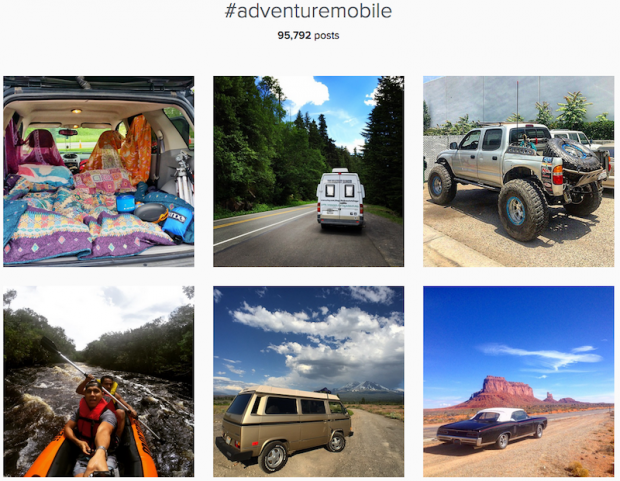
Get started with the app
To get started on Instagram, download it to your mobile device from the Apple Store or Google Play (it’s free). You’ll need to sign up, which means choosing a master email and a secure password.
Once you’ve entered the app, you’ll be prompted to fill out your profile. Take the time required to optimize it, filling it out completely and professionally.
Your username and bio: Instagram is one of the simplest social networks when it comes to your bio. Your username, for discoverability, should match the username of your other branded social media profiles. Your real name, in this case, is the company name. The only other information that appears on your public profile is your website (a url, which you can change to promote campaigns or new pieces of content) and a short, 150 character bio. For your bio, since you’re limited in terms of length, keep things straightforward, but not serious. Explain what your business is, what you do and what people can expect from your Instagram profile. It should be light and snappy. It should also include any branded hashtags you want followers to use.
Follow Instagram’s instructions on how to edit your Instagram bio.

Your profile photo: Your Instagram profile photo should probably be your company’s logo. Having it match your other profile photos will also help with discoverability, since people who follow you on Twitter or Facebook will instantly recognize your brand.
Your Instagram profile picture will be cropped into a circle on the app, so make sure you choose an image that will look good in that shape. Though the profile picture will be 110 pixels in diameter on the mobile app, choose a larger image since it will appear larger on the web.
Learn how to change your Instagram profile photo.
Enable notifications: This is an often overlooked aspect of setting up your profile. You’ll want to enable push notifications from everyone for likes and comments, as well as new followers, Instagram direct activity, and photos of you. These notifications are vital to engagement and any user-generated content campaigns you run. If someone tags your brand in a photo, a push notification puts it on your radar. You can then thank the user, comment or even share their photo as UGC. Notifications will help ensure you don’t neglect your Instagram presence, or the users that follow and engage with you.
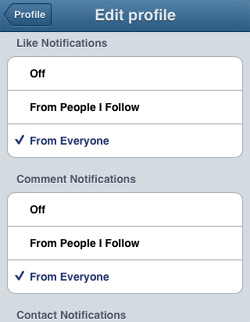
Follow people: Lastly, to kick off your business’ Instagram presence, you’ll want to follow a bunch of users. Find influencers in your industry, clients and engaging users and follow them. Search relevant industry hashtags and make your presence known by commenting on photos and following people who participate in these discussions. You’d be surprised how quickly this can expand your following on Instagram. Lastly, add your Instagram handle to your web properties and other social media profiles for cross-promotion. You can also send out a message or two asking your existing following on those networks to also follow you on Instagram.
After you’ve created your profile, add Instagram to your Hootsuite account. You can then create a number of streams, including hashtag searches, location searches, and your photos. Preparing these streams will set you up to quickly and efficiently tackle anything Instagram throws at you, from day-to-day engagement to integrated social media marketing campaigns.
Post and engage
Once you’ve set up Instagram, you can start sharing and engaging.
Post high-quality images that meet the brand guidelines you’ve established, and do so according to your content calendar. Remember, Instagram is very much a mobile-first platform, so consider that when choosing your photos. Consider how easily your image can be seen on a small screen and try and use high resolution photos.
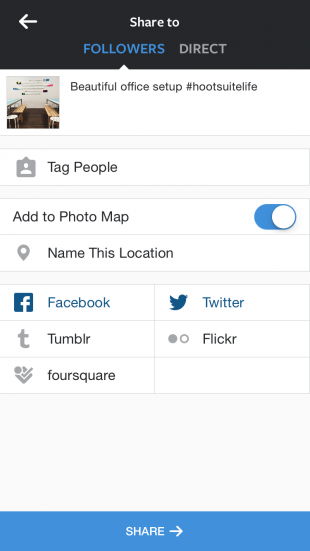
When posting, don’t miss out on opportunities to cross-post your Instagram images. The app allows you to post images directly to Facebook, Twitter, Tumblr, Flickr and Foursquare. You can also use the Instagram integration to cross-post images through Hootsuite whenever appropriate. Do it. It will help you grow your following by showing existing followers on other social networks that you’re on Instagram. It’s also an easy source of visual content for those social networks. The same premise applies to embedding images from Instagram within your blog posts and websites.
If you work in retail, food or any other business that has a physical location, make sure you also tag your photos with that location. This location tag can then be used by users to see other photos from your store or restaurant.
In terms of engagement, do your best to reply to comments from followers. Set up relevant search streams within Hootsuite to monitor industry-relevant hashtags, and like and comment on images. Don’t be afraid to follow users who follow you, especially those who clearly put work into their own Instagram presence. These people will be more likely to engage with your brand, and may even provide inspiration for your own posts. All in all, the success of your Instagram account will come down to getting your business out there in the community, while ensuring that you acknowledge and thank those engaging with your brand.
Pro tip: Don’t automate any of your engagement. I tried it, and it doesn’t work out so well.
5 Instagram for business best practices
Here are a few final best practices you can use to excel at Instagram for business:
- The unique qualities of your brand’s audience are still important on Instagram. A bank can’t simply mimic Starbucks or Red Bull and expect to gain popularity. Hone in on your audience and build an Instagram brand that really caters to their interests and expectations.
- Tell a story with your caption. Instagram is a visual social network, so many people end up neglecting the caption, when this is valuable real estate. Captions allow you to expand on the image, give it context and even make your followers laugh (especially if you are proficient in emojis). It can also tie an image back to your business.
- Instagram is a great platform for contests. Contests can ask users to comment on your photo, share it, mention a certain number of friends, or even share their own photo with a specific hashtag. Many users see these contests as a benefit of following a brand on Instagram, so don’t worry about bothering people. Try out a contest, track the analytics and see how it benefits your brand.
- Consider collaborating with a popular Instagrammer or influencer in your field or industry. Give them control of your branded account for a day, or ask them to share their thoughts on your brand. This could pay off big time as they expose your brand to their large Instagram community. While many influencers will charge a pretty penny for their services, even small and medium businesses can use this tactic by giving away their product or using local influencers.
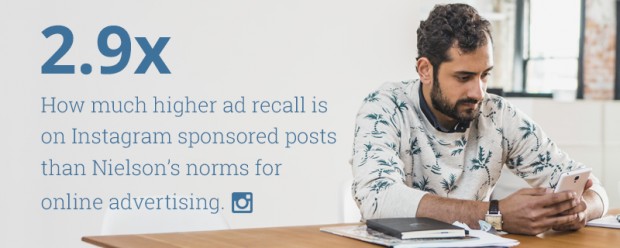
- Though it isn’t yet available to all brands, Instagram is progressively rolling out its advertising platform. Thus far, the results have been impressive. Across more than 475 global campaigns, ad recall from sponsored posts on Instagram was 2.9x higher than Nielsen’s norms for online advertising. This will be something to consider once Instagram opens up its advertising options to all businesses.
Save time managing Instagram by using Hootsuite to schedule posts, share video, and engage followers. Try it free today.
No comments:
Post a Comment